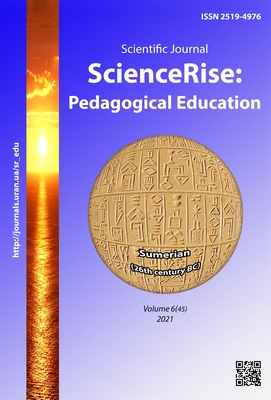The use of online technologies in the process of training future music teachers
DOI:
https://doi.org/10.15587/2519-4984.2020.246524Keywords:
digital platforms, virtual whiteboard, online learning, musical arrangement, creative tasks, algorithmAbstract
Modern graduates of higher educational institutions should be able to independently process information and be ready to acquire and use knowledge throughout their professional life. The actual task of education in the conditions that have formed in the world is the development of new educational technologies, which are added almost every year. The virtual world is becoming more and more diverse. The use of digital platforms is a pressing issue at a time when almost all information and activities are moving into the virtual world.
The article substantiates the use of digital platforms Zoom and Padlet, which are new in teaching technology. The issues of implementation of educational technologies in the process of training future teachers of musical art are considered. The capabilities of the web interface, which is the Padlet interactive whiteboard, which makes it quite popular in the education system, are analyzed. Using the capabilities of a virtual online whiteboard refers to new educational technologies. In-depth capabilities of work on the Zoom platform are shown. It has been shown, that the use of a multifunctional service affects the development of communicative and organizational skills of students. The process of connecting digital platforms Zoom and Padlet with music computer technologies is shown with specific examples. The organizational issues of conducting a practical lesson on arranging musical works using digital platforms are considered. The stages of preparation for arrangement are presented. An algorithm for creating a phonogram of a school song using Zoom and Padlet technologies, individual work and work in groups, which is one of the main issues of modern education, is shown. At the same time, the development of an integrated approach to the organization of effective educational activities in the conditions of an information and educational environment is relevant at the present time
References
- Vsemirnaya deklaratsiya o vysshem obrazovanii dlya XXI veka: podkhody i prakticheskie mery ot 9 oktyabrya 1998 goda (2021). Available at: http://www.conventions.ru/view_base.php?id=1496
- Dystantsiina osvita. Ministerstvo osvity i nauky Ukrainy. Available at: https://mon.gov.ua/ua/osvita/visha-osvita/distancijna-osvita Last accessed: 08.05.2021
- Dystantsiina osvita. Vyshcha osvita. Available at: http://vnz.org.ua/dystantsijna-osvita/pro Last accessed: 20.05.2021
- Polushkina, G. F. (2017). Uchebnye situatsii kak sredstvo formirovaniya universalnykh uchebnykh deistvii s primeneniem sredstv interaktivnoi doski. Kontsept, 9, 49–53. Available at: http://e-koncept.ru/2017/171020.htm
- Masharova, T. V., Polushkina, G. F. (2016). Interaktivnaya doska kak sredstvo realizatsii tekhnologii mediaobrazovaniya. Obrazovanie v Kirovskoi oblasti, 3 (39), 30–35.
- Nikolaienko, M. (2018). Interaktyvna doshka: teoriia i praktyka. Sumy, 94. Available at: http://www.soippo.edu.ua/images/Новини/2018/08/09/novost1/Інтерактивна_дошка_теорія_і_практика.pdf
- Padlet. Tsentr navchalnykh ta innovatsiinykh tekhnolohii. Available at: https://ceit.ucu.edu.ua/resursy/instrumenty/servisi-dlya-spivpratsi/padlet/ Last accessed: 15.05.2021
- Yak my krokuiemo do maisternosti (2021). Viddil osvity Ivankivskoi selyshchnoi rady ta KZ ISR «Tsentr profesiinoho rozvytku pedahohichnykh pratsivnykiv». Available at: http://osvita-ivankiv.gov.ua/2021/04/page/5/ Last accessed: 22.05.2021
- interaktyvnykh onlain-doshok dlia dystantsiinoho navchannia ta spilnoi roboty (2020). Nova osvita. Available at: https://osvitanova.com.ua/posts/4181-12-interaktyvnykh-onlain-doshok-dlia-dystantsiinoho-navchannia-ta-spilnoi-roboty Last accessed: 20.05.2021
- Onlain-doshky. Available at: https://educationpakhomova.blogspot.com/search/label/Онлайн-дошки
- Toffler, E. (2002). Shok buduschego. Moscow: OOO «Izdatelstvo ACT», 557.
Downloads
Published
How to Cite
Issue
Section
License
Copyright (c) 2021 Larisa Varnavska, Margarita Viktorova, Liliana Rymar

This work is licensed under a Creative Commons Attribution 4.0 International License.
Our journal abides by the Creative Commons CC BY copyright rights and permissions for open access journals.
Authors, who are published in this journal, agree to the following conditions:
1. The authors reserve the right to authorship of the work and pass the first publication right of this work to the journal under the terms of a Creative Commons CC BY, which allows others to freely distribute the published research with the obligatory reference to the authors of the original work and the first publication of the work in this journal.
2. The authors have the right to conclude separate supplement agreements that relate to non-exclusive work distribution in the form in which it has been published by the journal (for example, to upload the work to the online storage of the journal or publish it as part of a monograph), provided that the reference to the first publication of the work in this journal is included.








